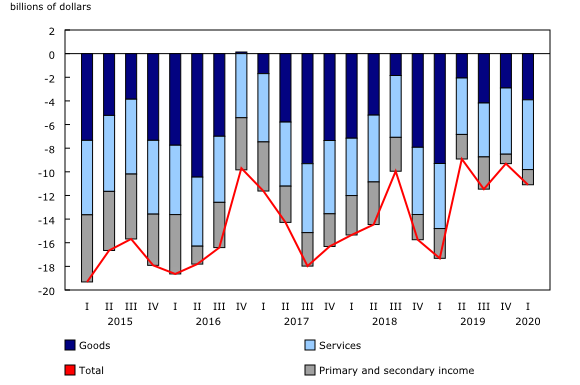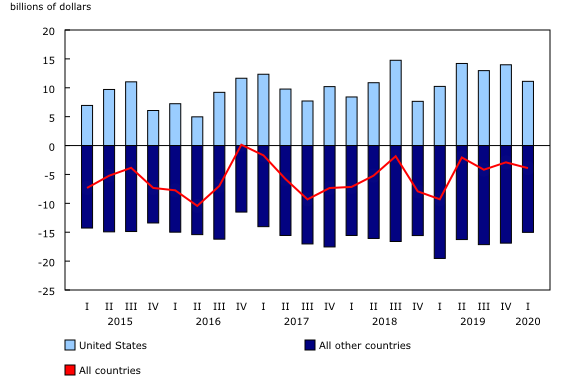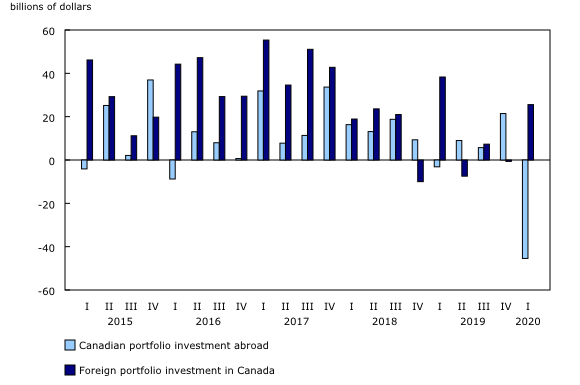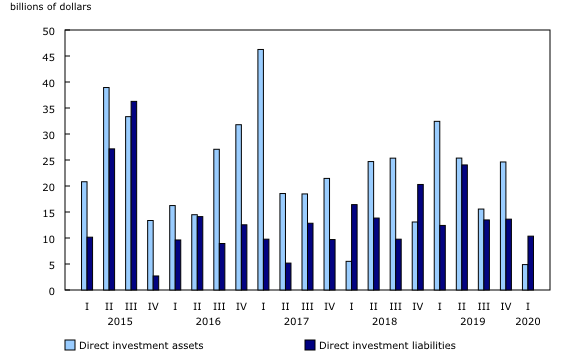Canada's balance of international payments, first quarter 2020
Archived Content
Information identified as archived is provided for reference, research or recordkeeping purposes. It is not subject to the Government of Canada Web Standards and has not been altered or updated since it was archived. Please "contact us" to request a format other than those available.
Released: 2020-05-28
-$11.1 billion
First quarter 2020
Canada's current account deficit (on a seasonally adjusted basis) expanded by $1.8 billion in the first quarter to $11.1 billion. The increase reflected a higher trade in goods and services deficit. This increase was partially offset by a higher surplus for investment income.
In the financial account (unadjusted for seasonal variation), inflows of funds from abroad to finance the current account deficit mainly came from transactions in securities. Strong foreign investment in Canadian bonds combined with record sales of US shares generated a $77.3 billion inflow of funds in the Canadian economy in the first quarter.
Global stock and capital markets showed higher volatility in the context of an intensifying COVID-19 crisis during the quarter and higher volumes of cross-border trading in both Canadian and foreign securities were observed.
Meanwhile, both Canadian direct investment abroad and foreign direct investment in Canada slowed. Overall, direct investment activity generated a net inflow of funds totalling $5.5 billion in the quarter.
Current account
Higher goods deficit as exports decline by more than imports
The trade in goods and services deficit rose by $1.3 billion to $9.8 billion in the first quarter, the highest deficit in a year. Both goods and services deficits increased during the quarter.
Goods exports decreased by $4.3 billion to $142.9 billion in the first quarter, a third consecutive quarterly decline and the lowest level since the first quarter of 2018. The largest reduction was in energy products, down $1.9 billion on lower prices. Exports of motor vehicles and parts were down $1.5 billion as automakers and several auto engine and parts suppliers in North America began to suspend production during the month of March.
Goods imports were down $3.3 billion to $146.8 billion, largely on lower imports of electronic and electrical equipment and parts, down $1.4 billion, and automotive products, down $1.1 billion, primarily from lower imports of motor vehicle engines and motor vehicle parts.
On geographical basis, the trade surplus with the United States was down $2.9 billion, mainly on lower exports of passenger cars and light trucks, and energy products. This was partially offset by a $1.5 billion reduction of the deficit with China as, notably, imports of electronic and electrical equipment and parts declined during the quarter.
The trade in services deficit expanded by $0.3 billion to $5.9 billion in the first quarter. The commercial services surplus shrank $0.4 billion. Higher financial services transactions, reflecting strong activities in the securities market, were the main factor in higher imports and exports of commercial services during the quarter. Both exports and imports of travel services were down in the first quarter as the COVID-19 pandemic and related travel restrictions considerably reduced the number of cross-borders tourists.
The investment income surplus increases
The current account is the broadest measure of cross-border transactions with the rest of the world, covering, in addition to trade in goods and services, international activity in the form of investment income and current transfers.
During the first quarter, Canada's investment income surplus increased $0.4 billion to $0.6 billion as both receipts and payments declined. Profits earned by Canadians on their direct investment abroad fell $1.4 billion, while on the payments side, profits earned by foreign direct investors on their direct investment in Canada were down $0.8 billion.
Financial account
Strong foreign acquisitions of Canadian bonds
Foreign investors increased their holdings of Canadian securities by $25.6 billion in the first quarter. They added debt securities, but reduced their exposure to equities.
Foreign acquisitions of Canadian bonds reached $46.9 billion, the largest investment since the third quarter of 2017. Strong foreign purchases of government bonds led the investment activity. New issues of private corporate bonds placed abroad and denominated in foreign currencies also contributed to the inflow of funds. The Bank of Canada lowered its benchmark overnight interest rate in the quarter and launched a series of measures to support the credit market as the effects of COVID-19 on the economy intensified.
Non-resident investors withdrew $13.4 billion of funds from the Canadian equity market in the first quarter, the third divestment in four quarters. Investors sold shares from all sectors of the Canadian economy.
Canadian investors massively sell foreign securities
As global stock markets experienced considerable losses, Canadian investors sold $45.4 billion of foreign securities in the first quarter, the highest such quarterly divestment on record. Canadian investors reduced their exposures to foreign debt and equity securities during the quarter. Holdings of foreign equities were down by a record $34.9 billion, led by sales of US shares.
Direct investment activity slows
Direct investment in Canada totalled $10.4 billion in the first quarter, down from a revised $13.6 billion in the fourth quarter. This was the lowest level of investment since the third quarter of 2018. Mergers and acquisitions activity amounted to $3.4 billion, down from $5.8 billion in the fourth quarter.
Direct investment abroad was $4.9 billion in the first quarter, the lowest level of investment since the second quarter of 2011. Mergers and acquisitions activity remained at a low level ($3.8 billion). Half of the investment was made by firms of the energy and mining sector and the bulk of the investment was in the United States.
Note to readers
As some data sources were received with delays and response rates to our quarterly surveys are lower due to current conditions, higher revisions in the data may be recorded in the coming quarters.
Definitions
The balance of international payments covers all economic transactions between Canadian residents and non-residents in three accounts: the current account, the capital account and the financial account.
The current account covers transactions in goods, services, compensation of employees, investment income and secondary income (current transfers).
The current account data in this release are seasonally adjusted. For information on seasonal adjustment, see Seasonally adjusted data – Frequently asked questions.
The capital account covers capital transfers and transactions in non-produced, non-financial assets.
The financial account covers transactions in financial assets and liabilities.
In principle, a net lending (+) / net borrowing (-) derived from the sum of the current and capital accounts corresponds to a net lending (+) / net borrowing (-) derived from the financial account. In practice, as data are compiled from multiple sources, this is rarely the case and gives rise to measurement error. The discrepancy (net errors and omissions) is the unobserved net inflow or outflow.
Foreign direct investment is presented on an asset-liability principle basis (that is, gross basis) in the financial account. Foreign direct investment can also be presented on a directional principle basis (that is, net basis), as shown in supplementary foreign direct investment tables 36-10-0025-01, 36-10-0026-01, and 36-10-0473-01. The difference between the two foreign direct investment conceptual presentations resides in the classification of reverse investment such as (1) Canadian affiliates' claims on foreign parents and (2) Canadian parents' liabilities to foreign affiliates. Under the asset/liability presentation, (1) is classified as an asset and included in direct investment assets, also referred to as direct investment abroad in this text, and (2) is classified as a liability and included in direct investment liability, also referred to as direct investment in Canada in this text.
For more information on the balance of payments, consult chapter 8, "International accounts," in the User Guide: Canadian System of Macroeconomic Accounts, available on our website. The chapter also presents the most recent balance of payments statistics.
Real-time table
Real-time table 36-10-0042-01 will be updated on June 8. For more information, see Real-time tables.
Next release
Balance of international payments data for the second quarter will be released on August 27.
Products
The product Canada and the World Statistics Hub (13-609-X) is available online. This product illustrates the nature and extent of Canada's economic and financial relationship with the world using interactive graphs and tables. This product provides easy access to information on trade, investment, employment and travel between Canada and a number of countries, including the United States, the United Kingdom, Mexico, China and Japan.
The Economic accounts statistics portal, accessible from the Subjects module of our website, features an up-to-date portrait of national and provincial economies and their structure.
The Methodological Guide: Canadian System of Macroeconomic Accounts (13-607-X) is available.
The User Guide: Canadian System of Macroeconomic Accounts (13-606-G) is also available.
Contact information
For more information, contact us (toll-free 1-800-263-1136; 514-283-8300; STATCAN.infostats-infostats.STATCAN@canada.ca).
To enquire about the concepts, methods or data quality of this release, contact Éric Simard (613-219-5932; eric.simard@canada.ca), International Accounts and Trade Division.
- Date modified:





